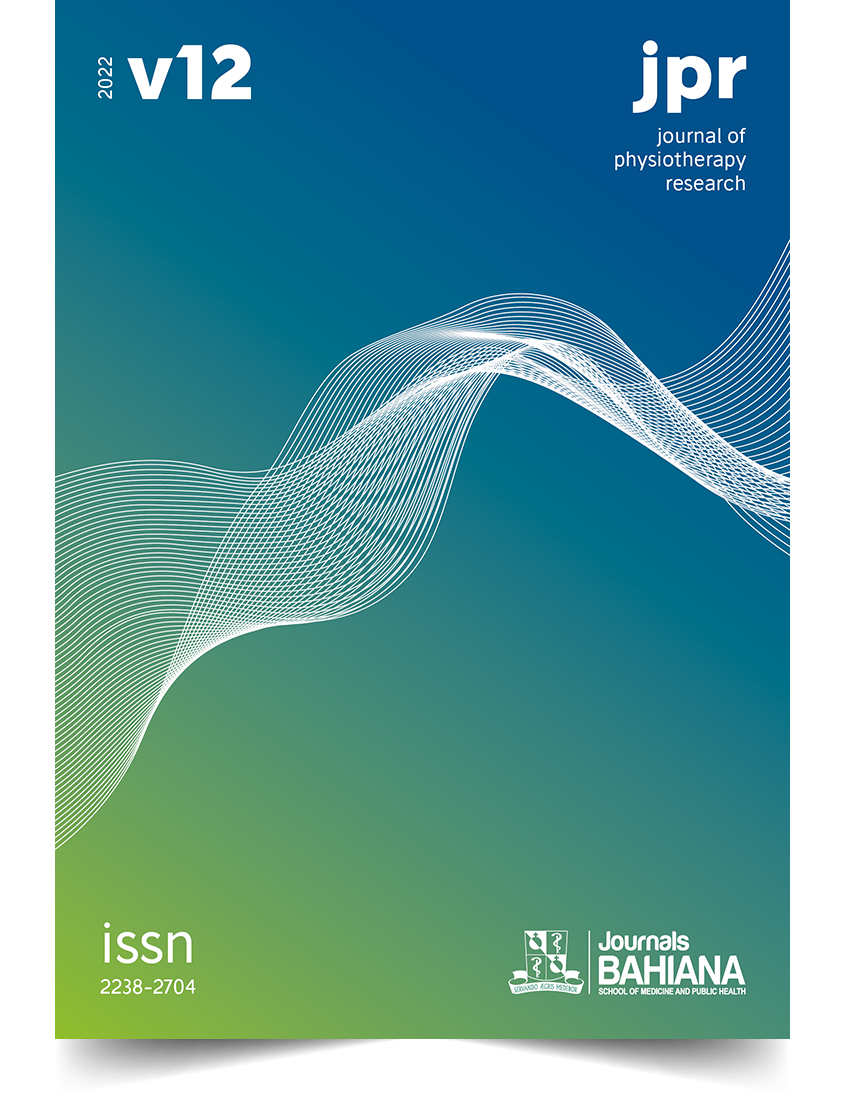Technological innovation: Development of an application for professionals working in the area of intensive care – UTI AUX
DOI:
https://doi.org/10.17267/2238-2704rpf.2022.e4583Keywords:
Mobile apps, Medical informatics application, Technological Innovation, Physical Therapy Department, Hospital, Intensive Care UnitsAbstract
INTRODUCTION: Professionals working in the area of intensive care (ICU) are constantly challenged to present a high level of performance and knowledge. In this scenario, the phenomenon of the use of mobile applications (also known as APPS) among the world population stands out. Thus aiming at easy and quick access to information in order to assist in decision making. OBJECTIVES: Develop an APP aimed at intensive care professionals. METHODS: The development of the application (APP) was made from the Expo platform, it was prepared on a computer and made available for the Android and IOS platforms. The themes present in the application were defined based on the knowledge of two Physiotherapists specializing in Physiotherapy in Adult Intensive Care with more than 10 years of experience. RESULTS: The APP uses an intuitive, touch-sensitive interface with quick access to the information that the user requests. There is a menu showing the buttons representing each function of the APP, such as: indexes and calculations; functional scales; laboratory tests; vital signs; weaning; mechanical ventilation (MV); non-invasive ventilation (NIV). In this way, the APP presents seven modalities. Application development time was 12 months. CONCLUSION: We developed an APP focused on professionals who work in ICUs, with the objective that they obtain information at the bedside as well as ease of use of evaluative instruments.
Downloads
References
(1) Sá Neto JA, Rodrigues BMRD. Tecnologia como fundamento do cuidar em neonatologia. Text context - enferm. 2010;19(2):372-377. https://doi.org/10.1590/S0104-07072010000200020
(2) Honorato DZS, Martins KQL, Vieira SKSF, Campos SAPBM, Almeida CAPL. O uso de tecnologias em saúde na consulta: uma análise reflexiva. Rev Interd. 2015;8(1):234-9.
(3) Ministério da Saúde (Brasil), Secretaria de Ciência, Tecnologia e Insumos Estratégicos, Departamento de Ciência e Tecnologia. Política Nacional de Gestão de Tecnologias em Saúde [Internet]. Brasília: Ministério da Saúde; 2010. 47 p. Disponível em: https://bvsms.saude.gov.br/bvs/publicacoes/politica_nacional_gestao_tecnologias_saude.pdf
(4) Felipe MSS. Desenvolvimento tecnológico e inovação no Brasil: desafios na área de biotecnologia. Nov estud CEBRAP. 2007;(78):11-14. https://doi.org/10.1590/S0101-33002007000200002
(5) Franco SB. Avaliação de tecnologia em saúde: perfil do usuário brasileiro do programa farmácia popular com hipertensão arterial diagnosticada [dissertação] [Internet]. Brasília: Faculdade Gama; 2017. Disponível em: https://repositorio.unb.br/handle/10482/23522
(6) Sabino LMM, Brasil DRM, Caetano JA, Santos MCL, Alves MDS. Uso de tecnologia leve-dura nas práticas de enfermagem: análise de conceito. Aquic. 2016;16(2):230-239. https://doi.org/10.5294/aqui.2016.16.2.10
(7) Sarmento GJV. Princípios e práticas de ventilação mecânica. 2ª ed. São Paulo: Manole; 2014.
(8) Emmerich JC. Suporte Ventilatório Contemporâneo. Rio de Janeiro: Revinter; 2002.
(9) Banos O, Villalonga C, Garcia R, Saez A, Damas M, Holgado-Terriza JA, et al. Design, implementation and validation of a novel open framework for agile development of mobile health applications. Biomed eng onl. 2015;14(2):S6. https://doi.org/10.1186/1475-925X-14-S2-S6
(10) Viana LS, Oliveira EN, Vasconcelos MIO, Moreira RMM, Fernandes CAR, Ximenes Neto FRG. Educação em saúde e o uso de aplicativos móveis: uma revisão integrativa. Gest Desevol. 2020;(28):75-94. https://doi.org/10.34632/gestaoedesenvolvimento.2020.9466
(11) Barbas CSV, Ísola AM, Farias AMC, Cavalcanti AB, Gama AMC, Duarte ACM, et al. Recomendações brasileiras de ventilação mecânica 2013. Parte I. Rev bras ter intensiva. 2014;26(2):89-121. https://doi.org/10.5935/0103-507X.20140017
(12) Justiano AN. Interpretação de Exames Laboratoriais para o Fisioterapeuta. Rio de Janeiro: Editora Rubio; 2012.
(13) Kawaguchi YMF, Nawa RK, Figueiredo TB, Martins L, Pires-Neto RC. Perme IntensiveCare Unit Mobility Score e ICU Mobility Scale: tradução e adaptação cultural para a língua portuguesa falada no Brasil. J bras pneumol. 2016;42(6):429-434. https://doi.org/10.1590/S1806-37562015000000301
(14) Riberto M, Miyazaki MH, Jucá SSH, Sakamoto H, Pinto PPN, Battistella LR. Validação da versão brasileira da Medida de Independência Funcional. Acta fisiátr. 2004;11(2):72-6. https://doi.org/10.5935/0104-7795.20040003
(15) Silva VZM, Araújo Neto JA, Cipriano Jr. G, Pinedo M, Needham DM, Zanni JM. Versão brasileira da Escala de Estado Funcional em UTI: tradução e adaptação transcultural. Rev bras ter. intensiva. 2017;29(1):34-8. https://doi.org/10.5935/0103-507X.20170006.
(16) Minosso JSM, Amendola F, Alvarenga MRM, Oliveira MA. Validação, no Brasil, do Índice de Barthel em idosos atendidos em ambulatórios. Acta paul enferm. 2010;23(2):218-22e. https://doi.org/10.1590/S0103-21002010000200011
(17) Barra DCC, Paim SMS, Dal Sasso GTM, Colla GW. Métodos para desenvolvimento de aplicativos móveis em saúde: revisão integrativa da literatura. Text context - enferm. 2017;26(4):e2260017. https://doi.org/10.1590/0104-07072017002260017
(18) Barra DCC, Dal Sasso GTM. Tecnologia móvel à beira do leito: processo de enfermagem informatizado em terapia intensiva a partir da cipe 1.0®. Text context - enferm. 2010;19(1):54-63. https://doi.org/10.1590/S0104-07072010000100006
(19) Osaku EF. Desenvolvimento de um software didático para o apoio ao aprendizado de ventilação mecânica [dissertação] [Internet]. Paraná: Centro Federal de Educação Tecnológica do Paraná; 2005. Disponível em: https://repositorio.utfpr.edu.br/jspui/handle/1/110
(20) Blumenthal J, Wilkinson A, Chignell M. Physiotherapists' and Physiotherapy Students' Perspectives on the Use of Mobile or Wearable Technology in Their Practice. Physiother Can. 2018;70(3):251-261. https://doi.org/10.3138/ptc.2016-100.e
Downloads
Published
Issue
Section
License
Copyright (c) 2022 Juliana da Silva Munhoz, Gabriel de Azevedo Pasini, Luiz Alberto Forgiarini Junior, Soraia Genebra Ibrahin Forgiarini

This work is licensed under a Creative Commons Attribution 4.0 International License.
This work is licensed under a Creative Commons Attribution 4.0 International License.



